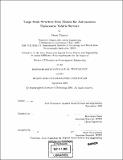Large scale structure from motion for autonomous underwater vehicle surveys
Author(s)
Pizarro, Oscar
DownloadFull printable version (21.60Mb)
Other Contributors
Woods Hole Oceanographic Institution.
Advisor
Hanumant Singh.
Terms of use
Metadata
Show full item recordAbstract
Our ability to image extended underwater scenes is severely limited by attenuation and backscatter. Generating a composite view from multiple overlapping images is usually the most practical and flexible way around this limitation. In this thesis we look at the general constraints associated with imaging from underwater vehicles for scientific applications - low overlap, non-uniform lighting and unstructured motion - and present a methodology for dealing with these constraints toward a solution of the problem of large area 3D reconstruction. Our approach assumes navigation data is available to constrain the structure from motion problem. We take a hierarchical approach where the temporal image sequence is broken into subsequences that are processed into 3D reconstructions independently. These submaps are then registered to infer their overall layout in a global frame. From this point a bundle adjustment refines camera and structure estimates. We demonstrate the utility of our techniques using real data obtained during a SeaBED AUV coral reef survey. Test tank results with ground truth are also presented to validate the methodology.
Description
Thesis (Ph. D.)--Joint Program in Applied Ocean Science and Engineering (Massachusetts Institute of Technology, Dept. of Ocean Engineering; and the Woods Hole Oceanographic Institution), 2004. Includes bibliographical references (p. 177-190).
Date issued
2004Department
Joint Program in Applied Ocean Physics and Engineering; Woods Hole Oceanographic Institution; Massachusetts Institute of Technology. Department of Ocean EngineeringPublisher
Massachusetts Institute of Technology
Keywords
/Woods Hole Oceanographic Institution. Joint Program in Applied Ocean Science and Engineering., Ocean Engineering., Woods Hole Oceanographic Institution.